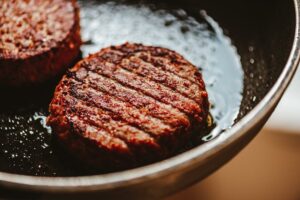
Article

When we think about “pandemic prevention”, we usually picture vaccines, face masks, and emergency stockpiles. But there’s another powerful line of defence to stop future outbreaks – and it starts with what we put on our plates.
You’ve probably already heard that diseases like COVID-19, Ebola, SARS, avian flu, and swine flu all originated in animals before spreading to humans and escalating into worldwide health crises. But what does that have to do with alternative proteins?
Well, what’s less talked about is that nearly all of these zoonotic disease outbreaks were made more likely, and more deadly, by the industrial scale at which we produce meat, eggs, and dairy – and the perfect storm it creates for viruses to proliferate.
Fortunately, there’s a new, safer, healthier protein on the table.
Alternative proteins (including plant-based meat alternatives, precision fermentation products, and cultivated meat grown from animal cells) are emerging as one of the most promising tools for preventing future pandemics and protecting public health – all while still feeding a growing population with delicious, nourishing food.
Why? Because they offer something animal products can’t: A safer, scalable way to feed the world, without triggering the next global health crisis.

With The World Health Organisation estimating that around 60% of all emerging infectious diseases and a staggering 75% of new human pathogens over the past three decades have animal origins, it’s little wonder medical historians are calling our time “The Age of Emerging Plagues”.
But what’s driving this alarming trend? Experts point squarely at industrial animal agriculture, especially factory farming, which represents the most profound alteration of human-animal relationships in thousands of years.
In the pursuit of ever-increasing profit, protein, and ‘productivity,’ the meat and dairy industry has drastically changed how farmed animals live – and in addition to being cruel and unethical, it’s putting us at risk.

The United Nations Environment Programme has identified animal protein demand and intensive farming as two top drivers of emerging pandemics. And when you look at how our food system currently operates to meet the demand for cheap meat, eggs, and dairy, it’s easy to see why.
Picture tens of thousands of stressed and sick pigs, cows, and chickens packed into filthy, overcrowded cages, sheds, and feedlots. Viruses thrive in these environments, mutating and spreading from animal to animal.
And with drastically reduced genetic diversity among farmed animals thanks to decades of selective breeding for profitable traits (like larger chicken breasts or faster egg production, for example), pathogens are free to spread from individual to individual like wildfire – without meeting stumbling-block genetic variants that might otherwise have slowed them down.
Worse still, the widespread use of antibiotics in animal agriculture has led to the rise of drug-resistant bacteria, or “superbugs”, which are bacteria that have stopped responding to the medicines we rely on.
The key takeaway? Our current food system isn’t just cruel to animals – it’s a public health crisis in the making.
Humans can contract zoonotic diseases from direct or indirect contact with animals and animal products.
As one expert from The Good Food Institute puts it: “Given our current methods of meat, dairy, and egg production, the risk of viruses leaping to humans is a matter of when, not if.”
The more we continue to farm animals intensively, the more likely it is that a zoonotic disease will leap the species barrier again.
Every stage of industrial-scale animal agriculture creates new opportunities for pathogens to spread:
Once contaminated meat, eggs, or dairy leave these facilities, they can carry harmful pathogens into supermarkets, restaurants, and home kitchens, turning everyday meals into potential sources of infection.

With the world’s population tipped to reach 10 billion by 2050, demand for protein is set to skyrocket. And meeting that demand with more factory farms isn’t just dangerous – it’s not even possible without massive consequences for animals, people, and the planet.
But what if there was a scalable way we could feed the world without the public health risks associated with animals, antibiotics, superbugs, or slaughter?
The world is at a crossroads when it comes to food … One area of innovation has the potential to bring health, climate, and food security goals together: alternative protein technology.
ICL Group
By completely removing factory farms and slaughterhouses from the equation, alternative proteins eliminate some of the most dangerous risks our current food system creates.
Experts urge that moving towards these next-gen protein sources isn’t just a personal ‘food choice’ anymore – it’s a matter of global public health.
Alternative proteins are a solution made for this moment. They help decrease emissions, feed more people with fewer resources, and restore biodiversity. They also address the urgent problems of antibiotic resistance and pandemic risk caused by our food system.
Bruce Friedrich, The Good Food Institute
Alternative proteins are protein-rich ingredients designed to emulate and replace animal-based proteins. Some are made 100% from plants, some are grown from animal cells, and others are brewed up by cleverly programmed microbes. Still, they all have one thing in common: They aim to deliver the same taste, texture, and nutrition as their animal-based counterparts, without any of the serious health risks associated with raising and slaughtering animals.
That means no factory farms, slaughterhouses, pathogens, or antibiotics, and minimal to no ongoing use of animals in the production process.
In the case of some cultivated meat and precision fermentation products (which we’ll get into below), the process may have started with a small input from an animal, like a one-time cell or gene sample. Still, as this technology matures, the trend is leaning towards processes that don’t involve animals at all.
Alternative proteins can help prevent future pandemics by decoupling food production from conditions associated with zoonotic disease transmission
Jessica Almy, Policy Director at The Good Food Institute
There are three main types of alternative proteins:
🌿 Plant-based meat alternatives: 100% plant-derived ‘meat’ products like sausages, burgers, meatballs, mince, seafood, and chicken, commonly made from ingredients such as wheat, legumes, and vegetables.
🍄 Precision fermentation products: Products made by turning microbes like yeast or fungi into organic factories that ‘brew’ animal or fungi-based proteins at scale. This category currently includes precision-fermented dairy (i.e. dairy-identical products made using the digital genetic blueprint of a cow, but without involving any actual cows in the production process) and mycoprotein products like Quorn (i.e. tasty, protein-rich meat alternatives derived from fungi).
✨ Cultivated meat: Real, bioidentical animal meat grown in a clean, controlled environment from a small ‘starter’ sample of animal cells, with many companies actively working towards establishing completely animal-free processes. Although sometimes referred to as cell-cultured or lab-grown meat, cultivated meat facilities look less like a lab and more like a highly advanced beer brewery.
Some consumers might not immediately see the appeal of cultivated meat or precision-fermented dairy, especially when satisfying plant-based alternatives to meat and dairy already abound. However, the fact that these products are indistinguishable from conventional animal products – yet have the power to drastically reduce animal and environmental harm and improve our global health – could make them a no-brainer for others.
Precision fermented dairy and cultivated meat are biologically identical to conventional meat and dairy at the cellular level, offering a seamless switch for food retailers and consumers who might not otherwise consider changing their habits or choosing a plant-based option.
These miraculous-sounding food innovations aren’t just wishful thinking. Cultivated meat, already on the market in Singapore, the U.S., and Israel, has recently been given the green light in Australia.
Precision-fermented dairy is also rapidly advancing, with Australia ramping up development ahead of commercial rollout, and products like animal-free whey and casein already on the shelves in the U.S.
As for mycoprotein and plant-based meat alternatives – these popular options are already in your local supermarket, on the menu at your favourite restaurants, and probably even in a few of your friends’ kitchens!
According to the 2025 Protein Alternatives Market Report:
The global protein alternatives market is experiencing remarkable growth, driven by increasing consumer demand for sustainable, ethical, and health-conscious food choices.
The skyrocketing popularity of alternative proteins is no mystery. Consumers are actively seeking ways to make a positive impact with their dietary choices while still enjoying the foods and flavours they love, and alternative proteins have created a powerful fork in the road for our eating habits.
We often think of pandemics as natural disasters, but they’re not. They’re the predictable result of systems we’ve built, and therefore, ones we can change.
Our animal-based food system is giving deadly pathogens the perfect opportunity to thrive. While there’s no silver bullet for preventing the next pandemic, choosing foods that don’t come from animals is a powerful—and delicious—place to start.
Just as consumer demand underpins our current food system, it also holds the power to reshape it.
Whether you’re open to trying cultivated meat or precision-fermented dairy one day, or can see the massive potential benefits these products hold for the future of food but would much rather enjoy all the delicious, nourishing products in the plant-based realm instead, one thing’s for sure: Every time you choose future-friendly proteins instead of conventional meat, eggs, or dairy, you’re ‘voting’ for a safer, smarter food system that protects people, animals, and the health of our whole planet.
Alternative proteins are so much more than just an exciting new food sector: They’re front-line defences against public health crises like COVID-19. So if we’re serious about preventing pandemics, saving lives, and creating a sustainable food system, it’s time to put alternative proteins at the heart of the conversation – and our plates. ![]()
What if plant-based burgers actually could save the world? 🤔 Grab your free Veg Starter Kit today to learn more about the health and environmental benefits of cutting back on meat and dairy. (Spoiler alert: There are a lot!)

Having grown up in a “meat and 3 veg” kind of household, Liv’s embarrassed to admit that she was a bit of a one-note chef until she began exploring the world of plant-based food. Vegan cooking has given her a whole new appreciation for the symphonies of flavours that simple, nourishing wholefood ingredients can create. (Even eggplant, once her greatest nemesis, is now — in a delicious, miso-glazed redemption arc — her all-time favourite veg.)